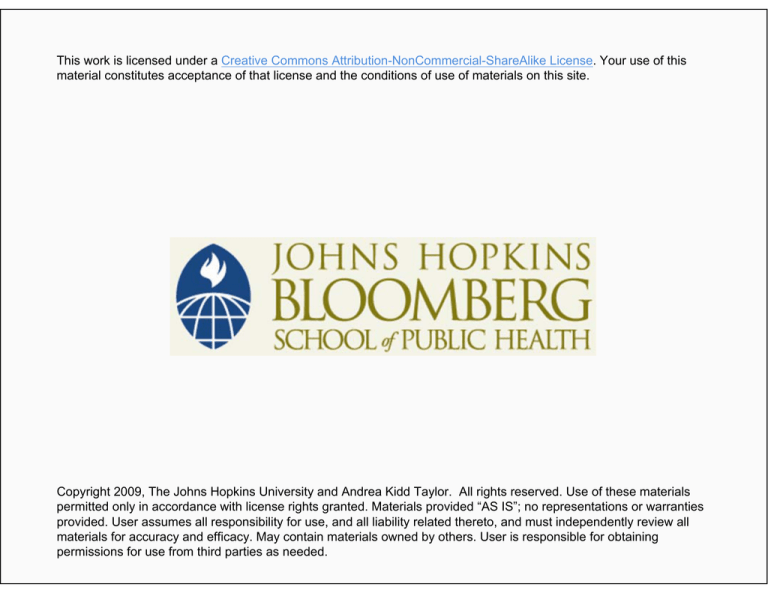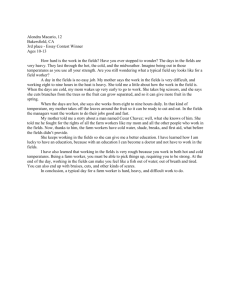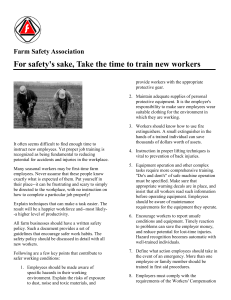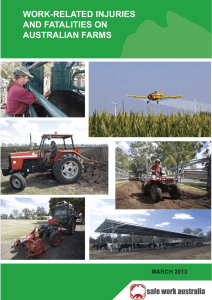
This work is licensed under a Creative Commons Attribution-NonCommercial-ShareAlike License. Your use of this
material constitutes acceptance of that license and the conditions of use of materials on this site.
Copyright 2009, The Johns Hopkins University and Andrea Kidd Taylor. All rights reserved. Use of these materials
permitted only in accordance with license rights granted. Materials provided “AS IS”; no representations or warranties
provided. User assumes all responsibility for use, and all liability related thereto, and must independently review all
materials for accuracy and efficacy. May contain materials owned by others. User is responsible for obtaining
permissions for use from third parties as needed.
Minority Workers and the Ongoing Struggle for
Environmental Justice in the Workplace
Andrea Kidd Taylor, DrPH, MSPH
Morgan State University SCHP
Introduction
Sheila Fitzgerald introduces Andrea Kidd Taylor
3
Section A
Overview
Environmental Justice in the Workplace
Disproportionate numbers exposed to occupational hazards and the
dirtiest, most dangerous jobs
Black workers—coke ovens, textiles, foundries, meat processing (U.S.
location)
Native Americans—uranium mining (N.M.)
Hispanics—agriculture (farms); construction
Asians, Hispanics, Blacks (Afr)—sweatshops and microelectronics
industry—repetitive strain injuries (RSIs)
Unemployment (linked to blood pressure elevations, mental health
problems, and excess morbidity and mortality)
5
Historical Perspective (African-American Workers)
1930s: Landmark silicosis disaster at the construction of Hawk’s Nest
Tunnel, Gauley Bridge, West Virginia (silica exposure)
1940s: Toxic and carcinogenic chromate dust exposures in the
chromate industry
1950s: Carcinogenic aromatic hydrocarbon exposures among coke
oven workers
1970s: Hazardous exposures in the textile and rubber industries
6
1991 Poultry Plant Fire
1991: Poultry Plant in Hamlet, North Carolina
− Devastating fire, locked safety doors
−
25 workers killed
X 12 African Americans
X
X
12 White Americans
1 Native American
7
Dynamics Affecting Worker Health and Safety
Two dynamics strongly impact worker health and safety
1. Poor working conditions—little career mobility (education and
health care access)
2. The lack of access to work—unemployment
X
Current rates
− African Americans: 10.2%
−
−
Latino Americans: 7.4%
White Americans: 5.1%
8
Farm Work
One of the most dangerous occupations
Seasonal workers: 71% Hispanic
Migrant workers: 95% Hispanic
Over 13% workplace fatalities in this industry are the result of
pesticide toxicity: 1,000 deaths reported annually; 300,000 reported
cases of illness
9
Farm Work: OSHA Regulations
OSHA regulations
−
−
−
Require field sanitation facilities (toilets,drinking water, and
hand washing facilities)
Cover toxic substance disclosure by requiring hazardous
chemical lists, material safety data sheets (MSDSs), employee
information and training
Only enforced on farms that employ 11 or more workers
(over 1 million workers are excluded)
10
Farm Work: EPA Regulations
EPA regulations
− 1992: Worker Protection Standard for Agricultural Pesticides
X
Requires farmers to …
1. Provide written or oral information on the type of
pesticide used on crops being harvested
2. Provide PPE for each farm worker
3. Restrict re-entry into fields after pesticide
application
11
Farm Work: JHHSA Study
Florida study in the winter 2002 Journal of the Health and Human
Services Administration
−
−
−
−
More than 50% of farm workers employed in California and
Florida
65% are employed in the production of vegetables, fruits, nuts,
tobacco, or sugar—labor-intensive work requiring heavy
pesticide application
Most are undercounted in the U.S. Census due to timing and the
migration north in April
Florida farm workers are a mix of Haitians, Jamaicans, Latinos,
and other (the majority are Hispanic)
12
Farm Work: JHHSA Study
Major health problems reported
− High rates of skin disease
−
−
−
−
−
−
Spontaneous abortions
Still births
Low sperm count
Sterilization
Cancer
Neurological and behavioral disorders
13
Farm Work: JHHSA Study
Problems in policy and enforcement
− Lack of reporting of pesticide-related illnesses
−
−
−
−
−
Lack of accurate data to reflect the number of workers injured
due to pesticide poisoning
Lack of awareness of physicians regarding reporting
requirements
Unfamiliarity regarding diagnosis and management of pesticide
poisoning
OSHA—small farms operate without basic sanitation facilities
EPA—lack of compliance by farm owners (workers in vicinity of
spraying, and improper use of PPE)
14
Construction Industry
Fatalities increased 67% between 1992 and 2001
Hispanics (Latinos) have a continuous growing participation
Latinos represent 15% of the construction workforce (13% of the total
U.S. population)
Fatal and non-fatal occupational injuries are higher
Non-fatal injuries and illnesses to Hispanic workers increased 7%
from 2005 (Bureau of Labor Statistics, 2006)
15
Construction Industry: Hazards
Most frequent fatal accident categories
1. Transportation incidents
2. Contact (being struck) with objects and equipment
3. Falls
X
X
Primary injury category: falls to a lower level
Comprise 37% of all Latino construction fatalities
16
Construction Industry: Hazards
Most frequent non-fatal work injury: contact (being struck) with
objects and equipment
17
Service Industry
Where most jobs are being created
Where workers of color are more likely to be employed
Occupations pay relatively low wages
Majority women
Nursing aides, orderlies, and attendants: 49,480 days away from
work due to non-fatal occupational injuries and illnesses—four times
the total for all occupations (Bureau of Labor Statistics, 2006)
18
Service Industry: JPHP Study
San Francisco, California, study in the Journal of Public Health
Policy (2002)
Industry make-up
− Room cleaners: 27% of the hotel industry
−
−
−
Food and beverage: 18%
Front desk clerks: 9%
Managers: 7%
19
Service Industry: JPHP Study
Demographic (ethnic and gender) make-up
− 99% of room cleaners are female
−
−
−
−
31%: Filipinos
35%: Asians
28%: Latinos
English not the first language for 95% of the room cleaners
participating in the study
20
Service Industry: JPHP Study
Health and safety hazards identified (survey questionnaire
and focus groups)
1. Physical job demands
X Increased garbage in rooms
X
Greater work to change linen
X
Little room to move around due to larger beds in
same small spaces
21
Service Industry: JPHP Study
Health and safety hazards identified (survey questionnaire
and focus groups)
1. Physical job demands
X Increased garbage in rooms
X
Greater work to change linen
X
Little room to move around due to larger beds in
same small spaces
2. Constant time pressure (job stress)
3. Lack of respect from supervisors
4. Poor job security
5. Poor job promotion prospects
22
Service Industry: JPHP Study
Health impacts
− High rates of work-related pain and disability
X
Of the 77% of room cleaners reporting musculoskeletal
disorder (MSD) work-related pain, only 50% reported the
pain to their supervisors or management
X
Only 23% formally reported work-related injury
23
Section B
Sweat Shops, Contingent Workers, and Unemployment
Sweat Shops
Are labor intensive and violate both safety and health laws and child
labor laws
Most workers are Hispanics, Asians, African Americans, and
individuals of African descent
Hazards most frequently reported
− RSIs
−
−
−
Overcrowding
Poor lighting
Abusive working conditions
25
“Contingent” Workforce
Part-time, temporary, and contract employees
Significantly increased in the past decade
Corporate restructuring (downsizing, franchising, and outsourcing)
−
−
Many companies “re-engineered” workplaces
Shift to “lean production”—lowering labor costs (no benefits,
health insurance, etc.)
26
“Contingent” Workforce
Examples of outsourcing maintenance work
− U.S. Petrochemical Industry
−
An indirect cause of several catastrophic explosions and
hazardous exposures (CSB Reports)
X
X
X
X
Tosco Oil Refinery (California)
Equilon Refinery (Washington)
Motiva Enterprises (Delaware)
Georgia Pacific (Alabama)
27
“Contingent” Workforce
Outsourcing on maintenance work
− Non-English speaking workers
−
Increased fatalities and worker injuries
28
Unemployment
Current rates
− 5.1% for Whites
−
−
10.2% for African Americans
7.4% for Latinos
Women have higher rates
Health risks
− Increased stress
−
−
−
Higher blood pressure
Heart disease
Adverse mental health
29
What Needs to Be Done
Improve surveillance and research
Reform OSHA
Reform workers’ compensation laws
Preventive interventions (worker training and risk communication,
community outreach)
Minority recruitment
Health care access
Treatment and compensation
30
What Needs to Be Done
Preventive interventions: Recommendations for Reducing Injuries &
Fatalities among Non-English Speaking Workers*
1. Provide safety and health training in a language appropriate to
the population (when possible, have a native of the language
conduct training)
*Source: The American Society of Safety Engineers. Retrieved June 2004 from www.asse.org
31
What Needs to Be Done
Preventive interventions: Recommendations for Reducing Injuries &
Fatalities among Non-English Speaking Workers*
1. Provide safety and health training in a language appropriate to
the population (when possible, have a native of the language
conduct training)
2. Provide linguistically appropriate and relevant health and safety
info and materials that address specific workplace hazards
3. Maintain a low student-to-trainee ratio
4. Training should be culturally sensitive
5. Provide financial and other support to encourage non-English
speaking workers to continue their education
6. Conduct on-the-job safety meetings in the appropriate language
of the workforce
*Source: The American Society of Safety Engineers. Retrieved June 2004 from www.asse.org
32
Section C
Q & A with Jacqueline Agnew
Q&A
How do you think we can reach employers?
34
Q&A
Can you tell me what some of the challenges are in education and
training?
35
Q&A
What are some of the programs offered?
36
Q&A
Tell me about the injured/ill minority worker
37
Q&A
Issues related to nurse aides
38





